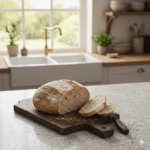Gluten-Free Sourdough Bread
Yields: 1 medium loaf
Prep Time: 30 min (active) + bulk fermentation 6–8 hr + final proof 2–3 hr
Baking Time: 50–55 min
Servings 1 loaf
Calories 145kcal
Ingredients
- 150 g brown rice flour
- 100 g sorghum flour
- 50 g oat flour certified gluten-free
- 50 g tapioca starch or potato starch
- 1 tsp xanthan gum or guar gum
- 350 –375g water warm
- 100 g active gluten-free sourdough starter
- 10 g salt
- 1 tbsp olive oil or melted butter optional, for richness
Instructions
Mix flours and water
- In a large bowl, whisk together the flours, starch, and xanthan gum. Add the water and stir until smooth. The mixture will be thicker than a batter but wetter than traditional dough. Let rest 30 minutes (autolyse).
Add starter and salt
- Stir in the gluten-free sourdough starter, salt, and oil (if using). Mix thoroughly until fully combined. The dough will feel sticky—this is normal.
Bulk fermentation
- Cover the bowl and let the dough rise at room temperature for 6–8 hours, until slightly puffed. Gluten-free dough doesn’t rise as dramatically, so look for gentle swelling rather than doubling in size.
Prepare for baking
- Line a loaf pan with parchment or lightly grease. Transfer the dough into the pan using a spatula. Smooth the top gently.
Final proof
- Cover and let the dough rest 2–3 hours at room temperature, or refrigerate overnight for deeper flavor.
Preheat oven
- Preheat to 425°F (220°C). Place an oven-safe dish of water on the bottom rack to create steam (optional, helps with crust).
Bake
- Bake for 50–55 minutes, until the top is golden brown and a skewer inserted in the center comes out clean.
Cool completely
- Remove the bread from the pan and let it cool on a wire rack for at least 1 hour. Gluten-free bread needs extra time to set before slicing.
Notes
Tips for Gluten-Free Baking
Hydration matters – Dough will seem wet; don’t add extra flour unless it’s extremely loose.
Patience is key – Gluten-free loaves benefit from longer fermentation and cooling.
Gentle shaping – Avoid kneading. Use a spatula to transfer and smooth the dough.
Flavor boosters – Add seeds, nuts, or herbs for texture and taste.
